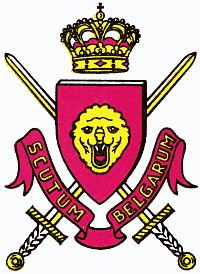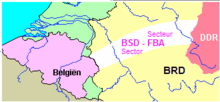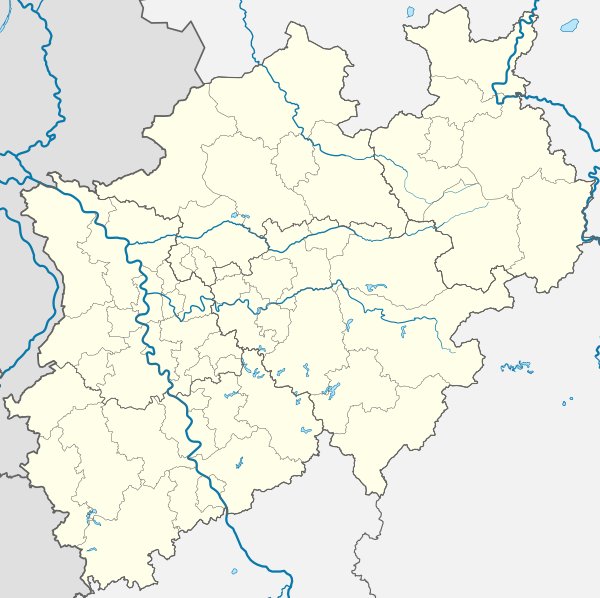Belgian armed forces in Germany
Belgian armed forces were stationed in Germany until 2002 . An Armée belge d'occupation already existed from 1918 to 1929 as part of the Allied occupation of the Rhineland after the First World War .
General
After the Second World War , on May 15, 1945, parts of the Piron Brigade were the first Belgian troops to march into Germany as auxiliaries on behalf of the British occupying army. The " Belgian Armed Forces in Germany" (nl. Belgische Strijdkrachten in Duitsland (BSD), French Forces Belges en Allemagne (FBA)) were stationed on the southern edge of the British occupation zone in an area of North Rhine-Westphalia and Hesse between Aachen and Kassel . The “Belgian Corridor” also included northern parts of Hesse (Kassel area) and thus extended into the former American zone of occupation, which was merged with the British occupation zone to form the bi-zone in 1947 .
The headquarters was set up in Lüdenscheid on October 25, 1946, but moved to Bonn in October 1948 (headquarters in Palais Schaumburg , other quarters in Troilokaserne and Deichmannsaue Castle ) before this city was declared an occupation-free zone by October 31 1949 had to vacate again and Bonn was designated the provisional seat of government. In November 1949 it moved its headquarters to the Haelen barracks, the former Etzel barracks of the Wehrmacht , in Cologne-Junkersdorf . There were also garrisons in Aachen, Bad Arolsen ( Antoine barracks ), Büren , Düren ( tank barracks ), Eschweiler , Euskirchen , Kassel (Liège barracks / De Gete barracks and artillery barracks / Noordvaart barracks), Cologne, Lüdenscheid , Rheinbach ( Tomburg barracks ), Siegen , Soest , Werl , Arnsberg ( Jägerkaserne ), Neheim and Troisdorf-Spich . From December 1946, the commanding officer of the BSD was General Jean-Baptiste Piron , after whom the 1st Infantry Brigade was also named Brigade Piron .
The status as an army of occupation ended when the Federal Republic was admitted to NATO in 1955.
Further stationing was contractually agreed between Belgium and Germany. The Belgian military was involved in NATO's military plans. In 1988 the Belgian armed forces in Germany comprised 26,900 soldiers who were stationed in 165 German locations and had three airfields and two hospitals. At times, around 25,000 Belgian women and children lived in Germany. In 1996 the command of the 1st Belgian Army Corps, which also included the BSD, was subordinated to the command of the Belgian Intervention Forces in Saive near Liège . In 1998 the number of Belgian soldiers in Germany had been reduced to around 2,200. The Cologne garrison was at times the largest Belgian garrison abroad. It existed until the end of 2003.
The base Camp Astrid near Eschweiler was vacated in 1995 after the Aachen site, Camp Gabrielle Petit in Aachen Hitfeld, had been given up in 1992. The Vogelsang camp and military training area in the northern Eifel , administered by the Belgian army from 1950 and used by other NATO troops since 1956 , was cleared in 2005 and put to civilian use. Camp Altenrath in Troisdorf was cleared as early as 2004 and, like Camp Spich, which had also been cleared, was initially to be used for commercial purposes. However, this ultimately failed, so that the barracks area in the middle of the Wahner Heide is now being renatured . In 2020 that was not yet over. Camp Spich, which was vacated during the same period, was converted into an industrial park.
The tasks of the Belgian army also include the guarding of nuclear weapons , including at the Wahner Heide special ammunition depot in Cologne and the Stilleking special ammunition depot in Lüdenscheid .
Territorial organization
Locations of the Belgian armed forces in Germany in 1990 (in brackets: closure before 1990) |
The stationing area of the Belgian armed forces in Germany extended over the southern edge of the former British occupation zone in North Rhine-Westphalia, and from 1951 came Waldeck and the Kassel area from the American zone. Over the years, many Belgian soldiers and their families have made their homes in the garrisons and like to refer to the Belgian locations as the "10th Province" in reference to the (then) nine provinces of the Kingdom of Belgium. Under the Etat-major Territorial FBA / Territoriale Staf BSD staff there were two "sectors" (East and West) with three "sub-sectors" each, in which the individual "places" and "garrisons" were combined. Structure 1983:
- Sector Est / Sector Oost Neheim
- Sous-Sector / Ondersector Arolsen
- Place / Plaats Arolsen, Brakel, Essentho
- Garrison / Garnizoen Korbach
- Sous-Sector / Ondersector Siegen
- Place / Plaats Lüdenscheid, Siegen (1980 still Attendorn)
- Sous-Sector / Ondersector Soest
- Place / Plaats Arnsberg, Büren, Neheim, Soest, Werl
- Sous-Sector / Ondersector Arolsen
- Sector Ouest / Sector West Cologne
- Sous-Sector / Ondersector Düren-Grefrath (1980 Grefrath)
- Place / Plaats Blankenheim, Düren, Goch, Grefrath, Mönchengladbach, Xanten (1980 still Erle, Euskirchen, Grevenbroich)
- Garrison / Garnizoen 1980 still caster
- Sous-Sector / Ondersector Cologne-Aachen (1980 Cologne)
- Place / Plaats Aachen, Cologne, Vogelsang, Weiden
- Garrison / Garnizoen Probsteierwald
- Sous-Sector / Ondersector Westhoven (1980 Spich)
- Place / Plaats Dellbrück, Spich, Westhoven
- Garrison / Garnizoen Altenrath
- Sous-Sector / Ondersector Düren-Grefrath (1980 Grefrath)
The commander of the 16th Div was also the commander of the east sector. The commanders of the 4th and 17th Brigades were the commanders of the Soest and Siegen sub-sectors; Arolsen was led by the commander ComRecce. Sector West was directly subordinate to the commanding general of the FBA / BSD; the sub-sector Düren-Grefrath included the garrisons with anti-aircraft missiles Nike of the Belgian air force (Force Aérienne / Luchtmacht). The seat of the administration was in Spich. In 1990 there were 23 locations, in 1995 only three locations (Spich, Altenrath, Vogelsang), 1,800 apartments between Siegburg, Cologne and Aachen, plus 8 schools and 6 medical facilities.
The life of families in Germany
Shortly after the end of the war, Belgium allowed the families of the occupying soldiers to move to the destroyed Germany. A 1946 pamphlet from the Ministry of National Defense gives an idea of the difficulties people faced. The army felt compelled to take on all essential tasks in the installation of the families. It regulated travel, housing, rent, heating, electricity and the supply of food. The soldier was assigned an apartment depending on his rank and marital status. The pioneers carried out the necessary repairs. Rations for firewood and coal for heating and food were made available. The army set up clubs, equipped shops and canteens , ensured medical care and took on the tasks of a travel agency . She also took care of social and cultural life. The military chaplains also looked after the families, schools for basic supplies were founded, as well as cultural associations. Theatrical performances and film screenings, organized by the organization “Welfare”, made life more pleasant. The teaching of older pupils in secondary schools began in 1947 in Honnef (name only from 1960 Bad Honnef); In 1950, the Athénée Royal Rösrath (ARR) was founded as a grammar school in Venauen Castle. After the administrative language separation in Belgium, the Koninklijk Atheneum Bensberg (KAB) was spun off as an independent grammar school in the Dutch language in 1965 in Bensberg Castle.
At the end of August 1946 there were 170 Belgian soldier families living in Germany; in 1965 their number was over 9,000. A further 2,300 apartments were built to accommodate them. These were managed by the Belgian organization KTG in Cologne-Weiden (with KSR West in Cologne-Ossendorf and KSR Ost in Soest ) was incumbent. Land remained in the possession of the Federal Republic of Germany. In 1965, eleven thousand pupils were taught at the two grammar schools in Rösrath and Bensberg and the 23 schools in the Belgian stationing area. There were three military hospitals in Aachen, Soest and Cologne-Ehrenfeld for medical care . The Cantine Militaire Centrale (CMC) organization was responsible for running the shops in the Belgian housing estates. The individual garrisons also had their own postal administration for the FBA / BSD, based in the Caserne Klerken / Klerken Kazerne in Cologne-Ossendorf , with regional Bureaux Postales Secondaires (BPS).
| Location | Field Post Office | Workforce | school | Military department store |
|---|---|---|---|---|
| Arolsen | BPS 37 | 1600 | 1951-1995 | Arolsen-Waldeck |
| Brakel | 1400 | 1966-1994 | ||
| Essentho | 1500 | 1968–1995 (1970 also middle school) | ||
| Wins | BPS 3 | 4650 | 1946–1995 (1975 also Lycée) | Hindenburgstrasse |
| Ludenscheid | BPS 10 | 3850 | 1946–1995 (new building 1975) | Herscheider Landstrasse |
| Soest | BPS 1 | 5850 | 1947–1995 (new building 1965, 1970 also Atheneum) | Bruderstrasse |
| Arnsberg | 1200 | 1946–1994 (1970 also middle school) | gardenstreet | |
| Büren | 400 | 1963–1992 (Belgian-American garrison school) | ||
| Neheim | BPS 6 | 1000 | 1946–1995 (new building 1955) | |
| Werl | 2500 | 1947-1995 | Walpurgisstrasse | |
| Düren | BPS 12 | 1952–1991 (1970 also Athénée) | Eberhard-Hoesch-Strasse | |
| Grefrath | BPS 41 | Kempen 1966-1991 | ||
| Blankenheim | 1968-1989 | |||
| Euskirchen | BPS 11 | 1946-1983 | Neustraße | |
| Goch | 1961-1995 | |||
| Mönchengladbach | 1953-1995 | |||
| Xanten | BPS 36 | 1966-1989 | ||
| Cologne | BPS 5 | Ossendorf 1951-1995 | Eupener Strasse, Äussere Kanalstrasse, Ebertplatz | |
| Aachen | BPS 9 | 1946-1994 | Freunder Weg, Großkölner Strasse | |
| Vogelsang | BPS 13 | 1952-2002 | ||
| Pastures | BPS 7 | 1947–1996 (new building 1955) | Bahnstrasse, Eichenstrasse | |
| Westhoven | BPS 4 | 1962-1995 | Urbach Siemensstrasse | |
| Dellbrück | 1948–1994 (new building 1950) | Bergisch-Gladbacher Strasse | ||
| Speak | BPS 14 | Troisdorf 1965-2003 | Central administration Troisdorf | |
| Bensberg | BPS 8 | Koninklijk Atheneum 1965–1997 | ||
| Rösrath | Athénée Royal 1950-2003 | Friedensstrasse |
The withdrawal of the Belgian armed forces from Germany was sealed on June 7, 2002 with a solemn ceremony in Spich in the presence of King Albert II and Federal President Johannes Rau. In the evening there was a big tattoo given by Defense Minister Rudolf Scharping for the Belgian Defense Minister André Flahaut.
See also
- List of Belgian military locations in Germany
- Belgian field post in Germany during the Cold War
- I. Corps (Belgium)
- Foreign military bases in Germany
Web links
- Museum of the Belgian Armed Forces in Germany in Soest
- Map of the distribution of troops in the 1980s
- Exhibition 2011 in Brussels <1945-2002 years of Belgian soldiers in Germany> (PDF; 221 kB)
- TV broadcast on WDR, part 1 on BSD
- TV broadcast on WDR, part 2 on BSD
- TV broadcast on WDR, part 3 on BSD
- detailed private website, in french
Individual evidence
- ^ History of the 1st Belgian Group 1940-1945, Brigade Piron, Veldtochen, Duitsland
- ↑ Reiner Pommerin : From Berlin to Bonn. The Allies, the Germans and the question of the capital after 1945 , Böhlau Verlag, Cologne 1989, ISBN 3-412-12188-6 , pp. 159–168.
- ↑ Walther Rotsaert: De belgische Bezetting in Duitsland , p. 59.
- ↑ In 1995 the province of Brabant was divided into a Walloon and a Flemish province and there are now ten provinces.
- ↑ Renseignements au sujet de l'installation en Allemagne des familles de militaires belges, édité par le Ministère de la Défense nationale, Brussels August 1946.
- ↑ See JP Cunibert, Luc De Vos, M. Strobbe, La force terrestre belge 1945–1980, published by Forum de la Force Terrestre, Brussels 1982, p. 26f.


